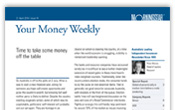As expected volatility is back with a dose of reality
Acknowledge the past but don't invest in it, Morningstar's Peter Warnes says, as there is no certainty the past, whether good or bad, will be replicated.
Following on from Tuesday's early edition of the Overview--From FOMO to FONGO--it was interesting there was not a tweet from the President about the rout on US markets on Friday and Monday.
Belatedly: "In the old days, when good news was reported, the stock market would go up. Today, when good news is reported, the stock market goes down. Big mistake."
The two-year budget deal stitched up in Washington on Wednesday, US time, will significantly increase fiscal spending. It will need to be funded by borrowings upwards of US$2 trillion. Bond yields reacted immediately, equity market gains vaporised.
It appears the President may not understand that while higher bond yields may signal higher economic growth, it doesn't necessarily mean stock markets move higher.
Meaningful expectations are already factored into valuations, but higher bond yields will impact discount factors applied to cash flow, which can reduce valuations.
Acknowledge the past, but don't invest in it. A company's record is useful and can provide some insight into the future, but there is no certainty the past, good or bad, will be replicated.
The equities market reflects the distilled expectations of investors. Expectations, by definition, are crystal ball gazing. The slavishly followed volatility index (VIX) measures the expectation of volatility over the next 30 days. Expectations have been shredded over the past week and global stock market indices have reacted accordingly.
All share valuations are based on expectations. Expectations for earnings involve numerous assumptions about the future including the outlook for bond yields (the risk-free rate), which determine the discount factor applied to future cash flows, to arrive at a discounted cash flow (DCF) valuation.
Bond yields are also used to value the assets of REITs, infrastructure, and utilities (the bond proxies) where capitalisation rates are tied to the risk-free rate.
Markets change direction when expectations change. The current shake-out reflects a change in expectations of inflation and bond yields. The knock-on effects on equity valuations starkly reflected in falling share prices.
Quite resolute expectations, backed up by the Dot Plot (the thoughts of each individual member of the Federal Open Market Committee), that the Fed will raise rates three times in 2018, now appear on increasingly shaky ground.
The more increases beyond expectations, the greater the risk equity values will come under increasing pressure.
Suggestions the market sell-off will become a buying opportunity state the bleeding obvious. But one can't buy unless funds are available to take advantage of the opportunities a falling market presents.
I have been urging subscribers to be squirrel-like over the past six months and I hope many have heeded the advice and sit patiently waiting to ambush the sellers.
Patience and a strategy required
The early bird catches the worm. My advice is not to be too early in buying into the current correction. Let it play out for a while. Rarely are corrections of two days duration. It is likely there will be more challenges ahead.
But it is also important to continue to focus on the long term and allow compounding to work for you. Those who have built cash reserves are in the best position to take advantage of undervalued situations as they present themselves.

Subscribe to Morningstar Premium and get access to invaluable investment research from Morningstar's award-winning and independent team of analysts, the high-performing Morningstar Income Equities Portfolio, indispensable stock and fund screening tools, and much more.
Already a Premium Member? Read it here
More from Morningstar
• Make better investment decisions with Morningstar Premium | Free 4-week trial
Peter Warnes is Morningstar's head of equities research. Any Morningstar ratings/recommendations contained in this report are based on the full research report available from Morningstar.
© 2018 Morningstar, Inc. All rights reserved. Neither Morningstar, its affiliates, nor the content providers guarantee the data or content contained herein to be accurate, complete or timely nor will they have any liability for its use or distribution. This information is to be used for personal, non-commercial purposes only. No reproduction is permitted without the prior written content of Morningstar. Any general advice or 'class service' have been prepared by Morningstar Australasia Pty Ltd (ABN: 95 090 665 544, AFSL: 240892), or its Authorised Representatives, and/or Morningstar Research Ltd, subsidiaries of Morningstar, Inc, without reference to your objectives, financial situation or needs. Please refer to our Financial Services Guide (FSG) for more information at www.morningstar.com.au/s/fsg.pdf. Our publications, ratings and products should be viewed as an additional investment resource, not as your sole source of information. Past performance does not necessarily indicate a financial product's future performance. To obtain advice tailored to your situation, contact a licensed financial adviser. Some material is copyright and published under licence from ASX Operations Pty Ltd ACN 004 523 782 ("ASXO"). The article is current as at date of publication.


